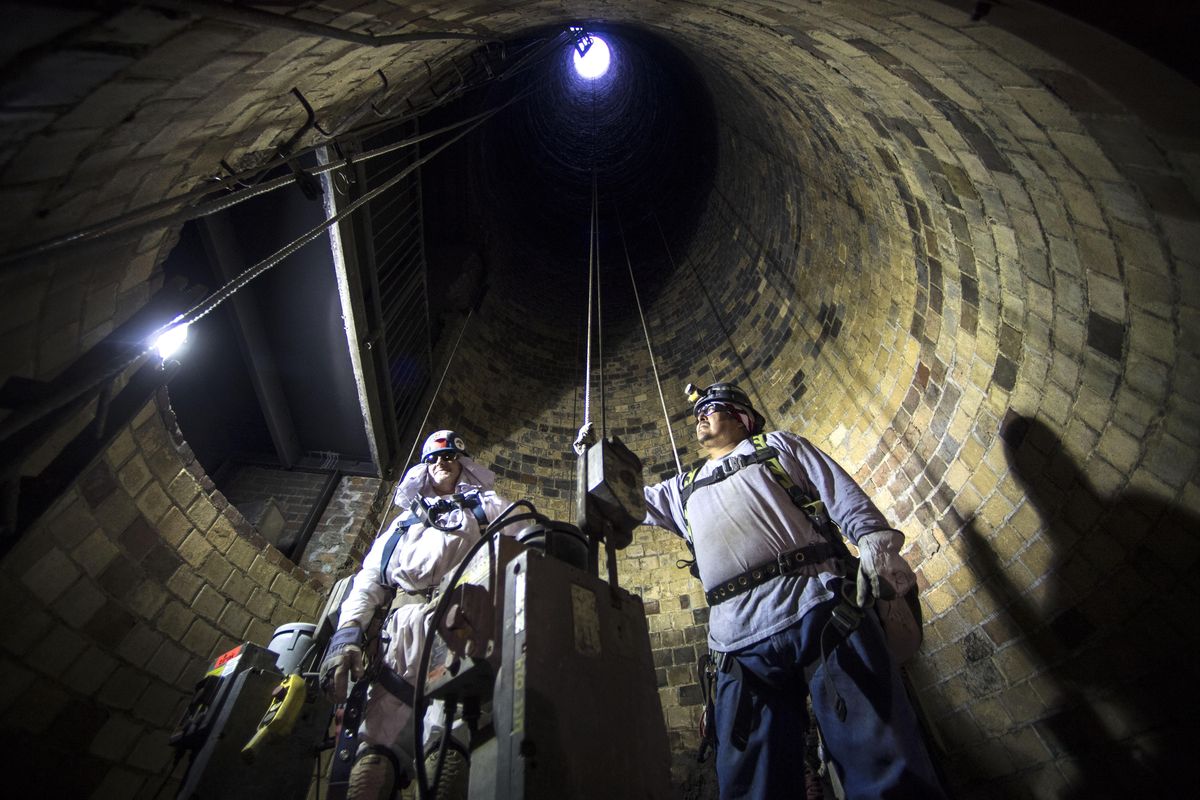Hitting the bricks: Spokane Steam Plant gets a makeover

Dale Jackson’s ears are burning. People are talking about him, and the Alabama man often overhears the comments.
The voices drift up from the street. Jackson, who works on a movable platform on the side of the 225-foot-tall Steam Plant stacks, can hear them distinctly.
“People are pointing and saying, ‘Hey, look up there.’ They’re watching us all the time,” he said. “They’re curious about what we’re doing.”
Being so visible is a novelty for Jackson, whose nickname, “Condor,” comes from the high-soaring birds. He works for Hamon Custodis Inc. of Salt Lake City, a company that specializes in industrial chimney construction and repair. Most of Jackson’s jobs are at coal plants in rural areas.
But this summer, he and his co-workers are cleaning the bricks and replacing mortar in the stacks at Steam Plant Square. The men have a bird’s-eye view of downtown Spokane – the trains, pedestrians and traffic on Interstate 90. Downtown residents are watching them, too, intrigued by the action overhead.
Each morning around 7, the crew members ascend the stacks on a platform built on a steel beam and secured by cables. Aside from lunch and restroom breaks, they spend their days above the city, power-washing the bricks, grinding away old mortar and replacing it with new. They come down about 4:30 p.m. each day.
The crew also works inside the stacks, whose walls are about 2 feet thick.
The project is part of a $1.5 million renovation at Steam Plant Square, part of which will include a new rooftop event center. The restaurant and pub there is temporarily closed, but will reopen in fall. The historic structure is owned by a subsidiary of Avista Corp.
The stacks were built in 1915 and 1916. For seven decades, they vented smoke from a coal-burning plant that supplied steam heat to the downtown business district. Avista Development eventually turned the plant and adjacent buildings into retail, office and restaurant space.
Tearing down the stacks was never a consideration, said Spencer Sowl, operations manager for Steam Plant Square.
“We’ve always wanted to keep the iconic smokestacks and this building,” he said.
The stacks are made of hand-laid bricks and were designed to sway slightly in the wind, Sowl said. They don’t have interior rebar or other reinforcement inside.
In the Steam Plant’s basement, there’s a metal door to the ash chute. “Custodis Chimney Company” and “New York” are stamped on the door. The company that built the stacks was known for its radial brick chimneys, and it was originally headquartered on the East Coast. Sowl finds it interesting that a successor company is doing maintenance work on the stacks a century later.
When Avista started the Steam Plant’s redevelopment, the decorative brickwork near the top of the stacks was covered under layers of soot. Cleaning revealed the woven pattern in the bricks. The current work will keep the bricks looking bright and prevent water from getting into cracks in the old mortar.
“As old as this chimney is, it’s the best-looking one I’ve seen for its age,” Jackson said.
The work is dirty, so the crew members wear Tyvek coveralls to keep the dust at bay. OSHA regulations also require workers to use half-face masks, safety glasses, earplugs and gloves.
“It takes a really tough guy to go up there and spend the day with the sun beating down on them,” said James Bain, the foreman.
Compared to the humidity of the South, however, or areas with frequent electrical storms or tornadoes, even 90-degree days in Eastern Washington are relatively pleasant, the workers said.
Crew members wear safety harnesses for fall prevention, but the job still requires a cool head and an ease with heights.
At Hamon Custodis, job applicants are asked whether they’ll be comfortable working several stories above the ground. If someone isn’t suited to the job, it’s quickly apparent.
“It’s pass or fail,” Bain said. “You can’t cheat.”
Crew members are finishing maintenance on the Steam Plant’s western stack and soon will be moving to the eastern stack. The work will continue about another four weeks, Sowl said.